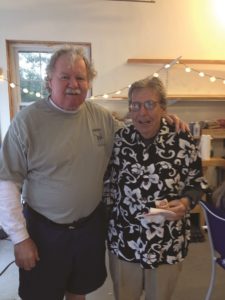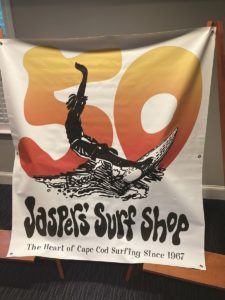EASTHAM — The origin story behind the Outer Cape’s most storied surf shop is a simple one. One summer day in 1967, after Kevin “Foggy” Foley ran out of gas on his way to Coast Guard Beach, Mike Houghton stopped to pick him up. Houghton was headed to the beach, too, with a board in tow. The pair spent the day surfing together. Afterwards, Houghton took Foley to a gas station on Route 6 in Eastham and showed him the shack next door where he planned to open Jasper’s Surf Shop. Then, he offered Foley a job.

In spite of its humble exterior, the shop would become the heart of surf culture on the Outer Cape, a community that had a knack for attracting and holding onto young surfers from across the country. To hear Foley recall it now, Jasper’s was “a destination, more like a clubhouse than a shop.”
Jasper’s was poised to ride the wave of surfing mania radiating out from California. In 1966, the surfing film The Endless Summer hit theaters. For many Americans, it was their first exposure to surfing, and it made an impression. According to Jack Farley, a longtime lifeguard for the National Seashore and one of Houghton’s close friends, the film sparked intense enthusiasm for surfing up and down the East Coast.
In the early days of the shop, Jasper’s connected with the community growing around the sport by assembling a team and traveling to competitions. Foggy Foley recruited Rick Weeks and his brothers at Four-Mile Beach (today’s White Crest) in Wellfleet. Together with Richard Farley of Australia and Californians Larry Gordon and Skip Fry, the hodgepodge group traveled down the Eastern seaboard in a van emblazoned with the Jasper’s logo. The van may have had more boards than the actual shop, which, Foley recalls, had only about five when they first opened.
Soon, however, Jasper’s was drawing the surfing community to Eastham. Tommy Dill bought up shacks and cottages that were for sale in various corners of Eastham and moved them onto the land immediately behind Jasper’s. Piecemeal, he assembled a surf colony in the back yard. Most of the shacks had no electricity or running water, so an electric wire was run from the shop to the biggest cottage, which the most illustrious of the surfers occupied.
As Dill remembers it, many of the cottages were rented by college students during the summer. Most wanted to learn to surf or were already competent surfers. They were also, in Tommy’s words, “nothing but trouble.” But not to Houghton and Foley.

The two agreed that Jasper’s should be “a home away from home” for the students and others who wandered in. They turned no one away, and would teach anyone to surf –– including, one summer, a college baseball player who had supposedly walked away from a $200,000 signing bonus with the New York Yankees. The shop also let the students pay for their boards over time. (Foley claims they were never stiffed.) They even forged beach passes for the young surfers.
Justin Kirchoff, now a professor of photography at the Maine College of Art, worked at Jasper’s for 10 years during the 1980s. The boundary, he observed, between the surfers, college kids, and employees of the shop could be difficult to discern. Often, he said, someone would come in, walk behind the counter to fetch something or put something away, and Kirchoff simply would not know whether that person worked there or not.
John Millikin, a Jasper’s employee for 20 years, echoed the point more succinctly when he said, “Jasper’s was a good time masquerading as a business. We had a ball, and we made some money.”
